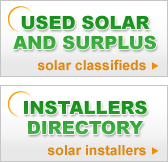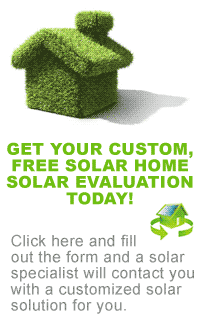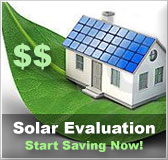|
|
We
will estimate the cost for each PV panel to be ~$400 |
For this starter system we are assuming no utility tie-in
and a totally independent PV system using on-site battery storage. We
talked about net metering and battery systems in Section 5B, page 14.
If you opt for a Trojan L16 battery, you’ll need at least two
for a 12VDC system (each L16 is 6VDC). For more cloudy day energy storage
you may want to upgrade to 4, 6, or 8 L16’s later on. We
will be using 2 – L16’s for this starter PV system.
We
will estimate the cost for each battery to be ~$250 |
The basic function of solar PV controller is to regulate and provide optimal current from the solar PV array to the batteries or utility grid. The controller provides many functions:
1. Regulates PV array current
to batteries
2. Prevents overcharging of batteries
3. Compensates for temperature variations
4. Compensates for various battery charging states
5. Can step-up or step-down voltage as needed
6. Provides Low-voltage disconnects
7. Protection and auto-resets on short circuits
Controllers can have a variety of output devices. Whether LEDs, digital displays, audible sounds or others; they can easily tell you the status of your PV system. Controllers are sized according to maximum array charging current. This is readily available from your PV panel spec sheet or manufacturer or distributor.
Fuses, disconnects and wiring
Many PV systems use readily available low-voltage automotive and RV/marine type fuses. These range between ¼” blade fuses, ‘SEA’ fuse blocks, Class ‘T’, ATO/ATC Powerhouse Fuse blocks; or other in-line fuse holders. Safety disconnects are needed for total system shutdown in case maintenance or repair work needs to be done; and for over-current protection. Circuit breaker protection are needed for all electrical loads.
There are also DC battery and load switches available to disconnect the battery system from your electrical loads and to switch between various battery arrays.
It is essential to have a knowledgeable electrical engineer or contractor design and install proper fuse and disconnect protection.
All connections should be properly terminated, soldered and/or sealed from outdoor and indoor elements. NEC codes must be followed – they are minimal requirements – not design criteria!
Of course you will need extensive wiring and terminations (connection points) for all of these components. You will also need to provide electrical connection to your lighting loads, and will want to replace your current lights with more energy efficient ones.
Inverters
Most American appliances are designed to run on 120VAC (alternating current voltage) at 60Hz (cycles per second) . Other countries may use 230-250VAC and 50Hz. Most renewable energy systems (solar, wind, hydro, etc) produce 12-48 VDC (direct current voltage). In order to power these appliances from a renewable energy source, an inverter is needed to convert the VDC to VAC.
An inverter is a device that electronically changes the low-voltage DC power to the standard high-voltage AC power required by most appliances.
Over the last few years, inverters have greatly improved. They are now quieter, more efficient, have a low ‘sleep mode’ power consumption, have better waveforms and have come way down in price. Most inverters manufactured in the last 5-10 years have between 88-97% efficiencies. Most inverters produce VAC using a modified sine/square wave. These inverters may emit electrical noise and interfere with radios, TVs, telephones, etc. A true sine wave inverter would avoid this, but would also be more than triple the price of a modified wave inverter.
We recommend you consider these minimum inverter features:
1. Reliability and safety
2 . Low battery voltage protection
3 . Over current protection
4 . Reverse polarity protection
5 . Thermally activated cooling fan
6 . Automatic ground switching
This is the most important requirement for an inverter (heck – for just about anything!). Most major inverter manufacturers that have been in business more than 10 years produce a reliable and safe product. Another way to asses this is to look at how the inverter is packaged and shipped. Reputable manufacturers know that packages can get shredded and trashed and provide extra foam molding and packaging protection.
2. Low battery voltage protection
This protects your battery system from excessive discharge. Some manufacturers provide an adjustable setting: A high setting allows the user to leave for an extended period while leaving security lights, refrigerators, etc. on without fear of harming the battery system due to discharge. A low setting on this may allow for a deeper discharge for special batteries that can handle it.
Should a high current suddenly be present, this will provide some protection from inverter failure.
4. Reverse polarity protection
In case of an inadvertent reversal of + and – wiring, or some other polarity failure, this feature will provide some protection from inverter failure.
5. Thermally activated cooling fan
When the inverter gets too hot, this feature will automatically provide a stable temperature allowing the inverter to continue doing its job.
6. Automatic ground switching if needed.
This feature is needed if you have an RV or marine PV system – it is strictly prohibited by NEC for residential and commercial application. Automatic ground switching disconnects the inverter’s internal VAC grounding when the inverter is hooked to a RV or shore (marine) remote power source. See the grounding section (page 19) for more information about why this is essential.
|
From each of the above sections our total estimated cost is :
|
*This is an estimated minimum price for these materials only. You will need to add labor costs, permits + inspections if needed, electrical load wiring, etc. Your actual costs will also vary depending on changes in these components’ prices, availability, freight and taxes. Please see www.solarhome.org for current prices.














